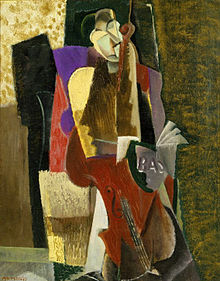I am fortunate to have had my education in 20th century art expanded by learning about the extraordinary life and art of Russian artist Moses Feigin. Because of Luba Matusovsky, I have had the additional privilege of experiencing Feigin’s work intimately. By themselves, the works in Ms. Matusovsky’s collection are significant, but her anecdotes about her friendship with Feigin, and the first-hand information she has about her works of art directly from the artist, make one feel as though the very breath of the artist still rests upon his creations.
Twentieth century American art, with which I am most familiar, is like a fast-moving mountain stream during springtime runoff. One school of artists quickly matures and bursts into rivulets that follow different influences, teachers and icons of independent thought. Perhaps this is because the American art is fortified with the inclusion of artists from Italy, France, Russia, Lithuania and England to name just a few. The classifications within American art, such as Social Realism, Expressionism and post-Cubist abstraction, are too lengthy to list here.
Russian art of the same period develops within the confines of extreme social and political restrictions. Freedom of artistic expression for much of the century only happens underground, and at great risk to artists and the institutions with which they associate. Very few artists are able to survive, with their true creative spirit intact, after figuratively being held under water and nearly drowned by state rule. The vast majority stay locked in step with Realism later opening itself to Russian Impressionism which remains prevalent today.
A handful of Russian artists who remain in the country until after the communist thaw create works in the contemporary tradition that virtually gasp with truth and brilliance. Moses Feigin and Irina Vilkovir, whose works are represented in the private collection of Luba Matusovsky, are two such artists. Because of his artistic talent and exceptionally long life (104 years), Feigin makes a contribution to the tradition of contemporary art unlike any of his Russian counterparts. In fact, Vilkovir regarded him as a great of his time, on the level of a Picasso.
It is only through a combination of grit, fluke and vodka-greased skids that Matusovsky’s art collection made it to the United States of America intact. It seems fitting that the works of these two artists should be viewed here within the framework of American works of the same time period.

Feigin’s works seem right in step with the Cubist and Futurist works of Max Weber (“Cellist,” 1917) who was born in Bialystok, Russia. American Charles Rain paints similar subject matter as Feigin’s harlequins with his 1934 work, “The Melancholy Clown.” Twentieth century contemporary art becomes all the more astounding when one considers that the works of so many artists who were completely isolated from one another explore common themes and take on similar qualities of abstraction.
For example, Feigin incorporates movie icon Charlie Chaplin in his paintings long before Andy Warhol adapted Marilyn Monroe for his famous works. Along the same lines, both Robert Rauschenberg and Feigin incorporated three-dimensional artifacts and “found” objects in their paintings while on separate continents without any knowledge of the other. Students of contemporary American art of the 20th century will find that Feigin’s works seem to find camaraderie with those of New Yorkers Abraham Rattner and John Marin, or Ben Shahn who came to America from Lithuania.
The Irina Vilkovir paintings in the Matusovsky collection also seem to resonate with the works of 20th century American artists like Bradley Walker Tomlin, Fritz Scholder, Georgia O’Keefe and Alfred Maurer. Vilkovir likely never conceived that her paintings would become a part of the collection of an American museum, but it is easy to imagine how she might have thrived in the arts environment available in America in the last century.
We live in a time when excitement about contemporary art is at an all time high. Thanks to Luba Matusovsky, our understanding of 20th century art is broader than it was before as we consider the significant contributions made by Moses Feigin and Irina Vilkovir.


